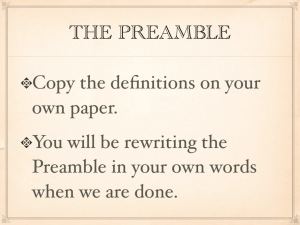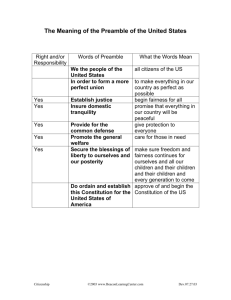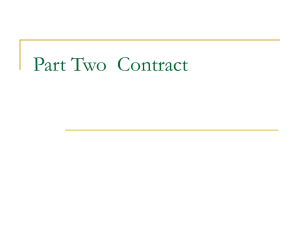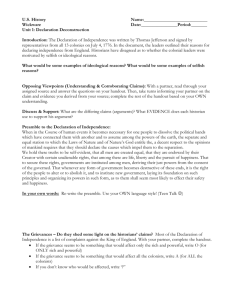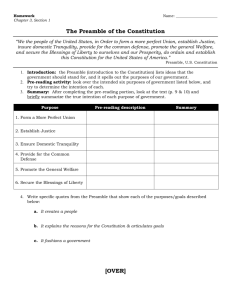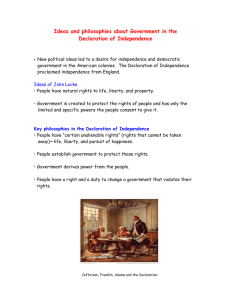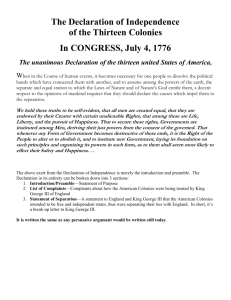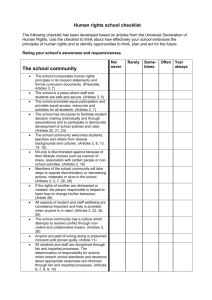1 The Beginning of Human Rights: The Ritual of the Preamble to
advertisement
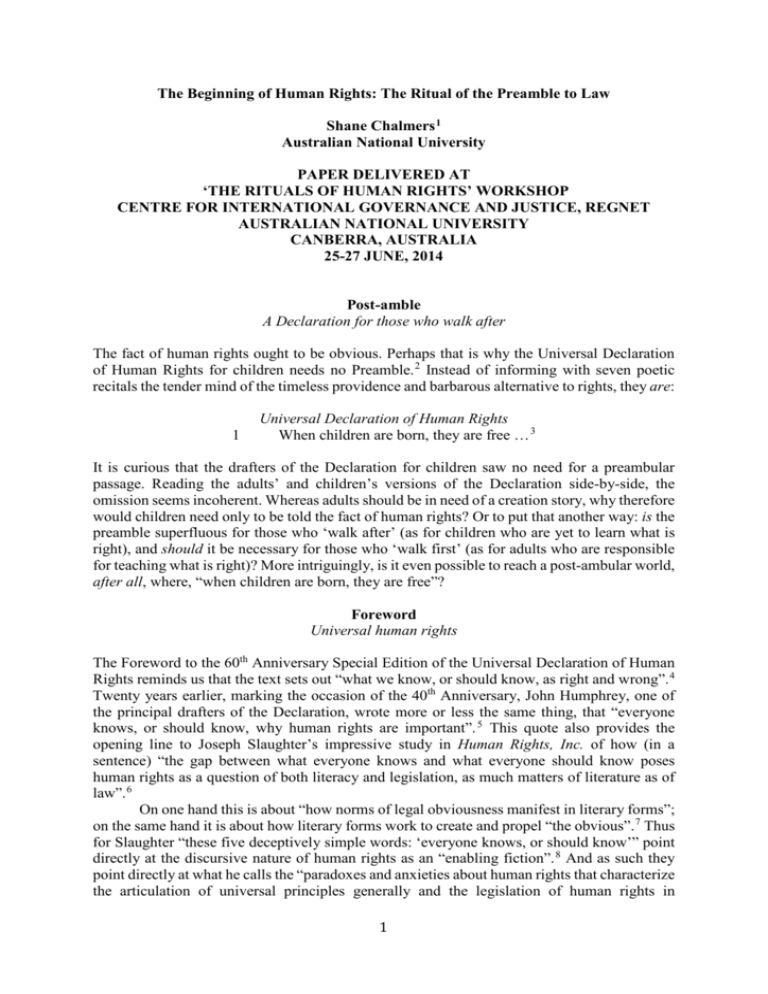
The Beginning of Human Rights: The Ritual of the Preamble to Law Shane Chalmers 1 Australian National University PAPER DELIVERED AT ‘THE RITUALS OF HUMAN RIGHTS’ WORKSHOP CENTRE FOR INTERNATIONAL GOVERNANCE AND JUSTICE, REGNET AUSTRALIAN NATIONAL UNIVERSITY CANBERRA, AUSTRALIA 25-27 JUNE, 2014 Post-amble A Declaration for those who walk after The fact of human rights ought to be obvious. Perhaps that is why the Universal Declaration of Human Rights for children needs no Preamble. 2 Instead of informing with seven poetic recitals the tender mind of the timeless providence and barbarous alternative to rights, they are: 1 Universal Declaration of Human Rights When children are born, they are free … 3 It is curious that the drafters of the Declaration for children saw no need for a preambular passage. Reading the adults’ and children’s versions of the Declaration side-by-side, the omission seems incoherent. Whereas adults should be in need of a creation story, why therefore would children need only to be told the fact of human rights? Or to put that another way: is the preamble superfluous for those who ‘walk after’ (as for children who are yet to learn what is right), and should it be necessary for those who ‘walk first’ (as for adults who are responsible for teaching what is right)? More intriguingly, is it even possible to reach a post-ambular world, after all, where, “when children are born, they are free”? Foreword Universal human rights The Foreword to the 60th Anniversary Special Edition of the Universal Declaration of Human Rights reminds us that the text sets out “what we know, or should know, as right and wrong”. 4 Twenty years earlier, marking the occasion of the 40th Anniversary, John Humphrey, one of the principal drafters of the Declaration, wrote more or less the same thing, that “everyone knows, or should know, why human rights are important”. 5 This quote also provides the opening line to Joseph Slaughter’s impressive study in Human Rights, Inc. of how (in a sentence) “the gap between what everyone knows and what everyone should know poses human rights as a question of both literacy and legislation, as much matters of literature as of law”. 6 On one hand this is about “how norms of legal obviousness manifest in literary forms”; on the same hand it is about how literary forms work to create and propel “the obvious”. 7 Thus for Slaughter “these five deceptively simple words: ‘everyone knows, or should know’” point directly at the discursive nature of human rights as an “enabling fiction”. 8 And as such they point directly at what he calls the “paradoxes and anxieties about human rights that characterize the articulation of universal principles generally and the legislation of human rights in 1 particular”. 9 The paradox here is that human rights are caught “between the world that the law imagines, or images, in principle and the one that it addresses in fact – between the ideal and the real”. 10 Or in other words: the paradox is that human rights ought to be a matter of fact (something we know), when in fact they are a normative matter (something we should know). And the “anxiety” is that this contradiction is a weakness that might fatally undermine the project that began after the Second World War with the Universal Declaration of Human Rights. Reading the children’s version of the Declaration side-by-side with the adult’s version, this paradox can be seen reflected in the treatment of the Preamble. On one side: a version that recites what has come before and what must follow, with the implication that human rights are what we should know, and this is why we should know it, even if we do not yet know it. On the other side: a version in which human rights are a matter of fact that only need to be stated to be known. From one perspective the difference between the two versions might seem incoherent; from another perspective – the view I take here – the difference is entirely coherent, but only if human rights are seen as oscillating incoherently between the ideal and the real, between what we should know and what we do know. Preamble A ritual passage As one half of the story, the Universal Declaration of Human Rights for children raises a question that goes to the universal idea of human rights: what of the preamble after all? What of those seven recitals in the Declaration for adults that invoke what has gone before and what must follow? Is it possible to have a Universal Declaration of Human Rights without a preambular passage, as the performative calling-forth of what goes before so that human rights might follow? And if not, what does that mean for the idea of human rights, if its end must begin with a preamble? The Preamble to the Universal Declaration of Human Rights seems to be thought about in three main ways. As the children’s version suggests, it might be merely the façade to a structure that would be without it nonetheless rock-solid, if less elegant: an evocative display, but of little consequence in itself. In line with this, René Cassin, one of its principal drafters, noted how the Declaration is comparable to the portico of a temple, with the Preamble as the front plaza – the entry into the temple. 11 But this image of the Preamble as the passage into a temple suggests it is more than a mere façade. It suggests it is also something much more intimate. Martii Koskenniemi points to this intimacy when he describes the Preamble as the “celebration” of the body of the text “from beyond the substance of the rights and principles and provisions that form the grandeur of the Declaration”. 12 Koskenniemi evokes the image of a manservant clothing his master to describe the relation between the Preamble and the Articles of the Declaration – an intimate act that connects servant and master but, of course, also marks their hierarchical separation. 13 Thus it is a celebration but also a “refusal”, with the Preamble excluded from the body of the text that is being celebrated. 14 Most often, however, the Preamble is seen as an instructive list of reasons to assist in understanding what the rights are in the Declaration. This is, by one account, how the drafters of the Declaration primarily saw its function. 15 And as a matter of jurisprudence, that would be fine. As international lawyers are taught to know, the preamble can reveal the object of the law (that to which the law is supposed to give expression). This flows in light of the Vienna Convention on the Law of Treaties from its contextual nature: as a principle of interpretation, the preamble appears at the start of the text to assist lawyers in their task of getting to its end, whilst, as context, it is kept out of the substance of the legal instrument. 16 2 So there are three ways of thinking about the preamble to law: a façade, entirely superfluous; a celebration and a refusal, intimately apart; and a positive legal instrument, pointing to what is significant and effective. But is that it? Or might the Preamble represent a façade that is even more intimate and even more positive? Might the Preamble be like the entry into a temple – the threshold that must be crossed to access the Articles of faith – but might this preambular passage be not apart from the substantive proclamations, but rather the very process that makes what is proclaimed ‘articles of faith’? Might the Articles given expression in the Declaration remain mere statements without the preambular passage? In short, to what extent might the preambular passage work to make the Articles a shared vision of reality, by initiating you, as one of us, most intimately and most positively into the universal temple of human rights? My provocation in this paper is whether the Preamble to the Universal Declaration of Human Rights might be read in this way, as such a ritual passage, both literally (as a passage in the text of the Declaration) and legislatively (as a passage to the law of human rights). In large part this follows Slaughter’s argument about human rights as “a question of both literacy and legislation, as much matters of literature as of law”. 17 It also follows Dylan Thomas, Plato, and the lessons of the Manusmṛti, amongst many others, in thinking about the literary-legislative form of the preamble. In this respect I am also indebted to Marie Theres Fögen’s illuminating notes on the history of preambles. 18 But I try to take it further than this by thinking about how the preamble to law is not only a question of literature and legislation, but also – and therefore – a question of ritual, and critically, how the ritual form of the preambular passage works to enable the “enabling fiction” of law. To put this another way, if “norms of legal obviousness manifest in literary forms” at the same time as literary forms work to create and propel “the obvious”, 19 then the ritual recitation of what has come before and what must follow, again and again, is a foundational part of this performance, working to enact in a most intimate and most positive way what should be as a matter of fact, in you, as one of us. The end of the end of the preamble “Here then, people, the law” The preamble to law has had many ends in history, two of which are relevant here. 20 The first, which has been one of its traditional “reasons” or “purposes” throughout history, is its worldcreating potential. The second, which is of a more modern occasion, is its “abolition”, on the utterly rational grounds that democratic law has no need for such a preambular passage – the reason for the preamble thus becoming the reason for its abolition, or in other words, the end of the end. With respect to the first of these ends, humans have known for a very long time the normative effect language can have and, more to the point, how this can be world-creating. Not so long ago Dylan Thomas wrote: “A good poem helps to change the shape and significance of the universe, helps to extend everyone’s knowledge of himself and the world around him”. 21 Some time before that, Plato turned his mind to the persuasive power of language – of the rhetorical and the poetic – and of particular interest here, wrote in light of this about how “the prelude to law” (what today would be called a preamble to a legal instrument) is nothing less than law in its persuasive form. 22 Thus Plato wrote: 3 To ensure that the person to whom the lawgiver addresses the law should accept the prescription quietly – and, because quietly, in a docile spirit, – that, as I supposed, was the evident object with which the speaker uttered all his persuasive discourse… The lawgiver must never omit to furnish preludes, as prefaces both to the laws as a whole and to each individual statute… One ought to preface each enactment with the prelude that naturally belongs to it—for the statement that is to follow the prelude is one of no small importance, and it makes a vast difference whether these statements are distinctly or indistinctly remembered. 23 Around the same time as Plato, several centuries Before the Common Era, the Manusmṛti of ancient India set down one of the first extant legal codes. After beginning with a preambular passage, a dialogue that recounts the creation of the world and the origin of the law, we are told: “Thus the origin of the sacred law has been succinctly described to you and the origin of this universe; learn (now) the duties of the castes (varna)”. 24 The duties or laws you must now learn in light of what has come before are also inextricably bound up in the Manusmṛti with the performance of holy rites, to ensure you lead the right life from birth to death. The implication being: to really learn the law, it is not enough that it be stated; it must also be performed, again and again, ritually. However, putting it this way suggests a separation between law’s expression in word, and its performance in practice, with the words providing instructions on the rites, which are then “implemented” when put into practice in everyday life. To an extent there is such a separation between text and practice, between a textual passage and an embodied passage. It is not enough to merely state the rites that have been set down in the provisions of a law; those rites must also be performed as a physical enactment for the normative order they contemplate to become a factual commonplace. 25 But it is also true that the performance is already taking place before the shift from “text” to “practice” – that the passage in the text and the passage in practice are not so separate. This is recognized in the Manusmṛti when it instructs: “Let him always pronounce the syllable Om at the beginning and at the end of (a lesson in) the Veda; (for) unless the syllable Om precede (the lesson) will slip away (from him), and unless it follow it will fade away”. 26 Even with little knowledge of Hindu theology and the significance of the incantation of Om, it seems reasonable to conclude (for the reasons I discuss next) that the instruction to recite the law in this way is about making the text a performance that is an intimately positive act. That is, such recitation is about the internalization of knowledge (of what you should know as a matter of right) and therefore its “implementation” as a reality within you (as something you do know as a matter of fact). 27 Without the ritual of the recital, re-calling again and again a universal truth (in this case in the sound of Om), the lesson remains something that should be known but that is not yet known (slipping your grasp) or soon forgotten (fading away). This is also Plato’s point: the preamble, as a prelude to law, can work to persuade subjects that the world the law imagines aligns, or should align, with their own image of the world. Without this the law would remain a mere statement “indistinctly remembered” (slipping your grasp, fading away). So humans have known for a very long time not only that language and ritual can have a powerful normative effect – that they can be world-creating in fact – but also that the performance of a text does not begin only after one moves from “the word” to “the real world”, or from “law in the books” to “law in practice”, because they are not so separate. The performance may have already begun the moment the words are called forth and set down in the text, and every time they are re-called. If to perform is to give form through action, then this act of reciting through a text, again and again, what has come before and what must come 4 after, is surely just that: a performance. And this is both a deeply intimate and an intensely positive act: not only is “the real world” (what has come before, the “whereas”) constituted in the text, but “the real world” (what comes next, the “therefore”) is constituted as a reality, in you, as one of us, through the ritual passage. But it is for this reason, Fögen writes, that the preamble to law appears undemocratic, in seeking to bring about normative change through the law, rather than the law merely being a statement of the normative disposition of the demos. 28 The preamble to law appears to be evidence of the fact that the law is not yet law but an attempt at social transformation from above – an attempt by law-makers to enact, most intimately and most positively, the world of the law within its subjects. And it is for this reason, Fögen recounts, that the preamble was abolished from the modern law of France with the French Revolution. 29 Because the “law-giver” was seen to be one-and-the-same as the “law-recipient” under France’s revolutionary republican system of government, the law was seen to be a mere expression of the will of the French people (or at least of those who counted). 30 In this post-ambular state, all that would be required for subjects to recognize their law as law would be a statement of “the law”, as it exists at this moment in place and time (“here then”), as a reflection of the will of the “people”. In Robespierre’s preferred formulation, all that would be required in prelude to the law is the acknowledgement by the sovereign: “Here then, people, the law, which your representatives have made and to which I added the royal seal”. 31 As in the children’s version of the Universal Declaration of Human Rights, the preamble could be omitted at long last. But could it? After all, in the end, even the French Revolution does not escape the fact that it too began with a preamble – that the post-ambular world in which law-giver and lawrecipient are one-and-the-same was established through the Preamble to the French Declaration of the Rights of Man and the Citizen. 32 And so even the modern democratic end of the preamble would appear to begin with its traditional undemocratic end, which suggests it is no end at all but rather a beginning. The beginning of human rights Positive law “most intensively” The thought that the reason of the preamble can lead to its abolition – the thought that a society can pass through a law’s preamble into the world it creates, and then, at that point, the preamble can be done away with as no longer necessary – was the promise of the French Revolution, and it remains the promise of human rights. The idea of the end of the end of the preamble is thus the idea of a post-ambular world in which what we should know is also what we do know, once-and-for-all. The question that remains is whether that is ultimately realizable, or whether the end of the end is rather an endless beginning, making the post-ambular ever-dependent on a preambular passage without end. To think that through I return to the beginning of human rights, which here begins at the start of the twentieth century with the period of the two World Wars and the return of the preamble as positive law “most intensively”. 33 These are the words of the German philosopher and legal theorist of the Third Reich, Carl Schmitt, who encouraged the deployment of the preamble in Nazi legislation for precisely its National Socialist world-creating potential. 34 For Schmitt the type of formulation “here then, people, the law” represented a naïve legal positivism. Instead, for “the law” to be law, in the most intimate and most positive way, the world the law posits must be realized within the minds of the people. Schmitt advocated the use of the preamble in Nazi legislation to this end, as an even more “intensively positive” legislative act than the legal 5 positivist one of simply stating “here then, people, the law”. 35 In this the preamble to law is about taking an idea of “the will of the people” and not just stating that it is their will but working to make it in fact the will of the people. This is, in short, about getting from what the people should know to what they do know, as Folk. Thoroughly opposed to that vision, and in light of its destruction, the United Nations General Assembly proclaimed and adopted the Universal Declaration of Human Rights in 1948, marking the beginning of the contemporary international human rights system. And yet, thoroughly opposed to the destructive irrationality of Nazism and Fascism, the idealistic vision of human rights turns on the same intensive legal positivism for its realization. In making this argument here I draw on Johannes Morsink’s comprehensive study of the “origins, drafting and intent” of the Universal Declaration of Human Rights. 36 What his account makes clear is that the project of drafting a universal declaration of human rights was an idealistic and visionary enterprise, 37 and moreover, that the drafters made “moral transcendence” the idealistic basis of human rights (rather than, for example, grounding them in State sovereignty) in order to condemn the horrors of the Nazi and Fascist States. 38 The extent of the drafter’s idealism, and the extent to which the Declaration was intended to be world-creating, is perhaps most succinctly captured in the title of a paper written on the tenth anniversary of the Declaration by Cassin: “How to Achieve a Better World: The Universal Declaration of Human Rights”. 39 At the same time, however, these idealistic visionaries did not think that the Declaration represented a fictitious or aspirational list of human rights that people everywhere did not already possess. Rather, as a “common standard of achievement for all peoples and all nations”, 40 the drafters considered human rights to be what everyone already possesses as humans, even if we do not yet know it. The Declaration, as far as the drafters were concerned, “can only serve as a standard of achievement in the areas of implementation and of enjoyment of the rights listed”, making it “an educational text to tell people about all the inherent rights they already have”. 41 Thus the Declaration is imagined idealistically as an “educational text” the end of which is the “implementation” of its idea as a reality in us, by teaching us our inherent rights. 42 This educational purpose is reflected in the Operative Paragraph of the Preamble, which proclaims human rights education to be the document’s specific “end” to be achieved by “keeping this Declaration constantly in mind”. 43 It is also reflected in the title of the text, with the word “Universal” intended to signify the Declaration, and only then, indirectly, human rights. 44 This is not the “Declaration of Universal Human Rights”. Literally the word “Declaration” intervenes, connecting “Universal” and “Human Rights” (an idea that is then held together by keeping the Declaration constantly in mind). In this way the drafters framed human rights in the Declaration as both inherent and without any immediate grounding – the coherence of which is its incoherent oscillation between fact (of being human) and norm (of becoming human). What is even more remarkable is that this is the result of the “universal” character of the text itself. Morsink sums this up in an illuminating passage in which he shows how, because the drafters came from such a rich plurality of backgrounds, they could not agree on what exactly it is to be human and could only agree on what it ought to be human. 45 Thus as a result of its immanent universalism – inscribed into the text by the “universal” composition of the drafters themselves – the Declaration took form not simply as a determinate ontological statement of fact (simply stating that humans have rights as a matter of being human) but as an epistemic vehicle “by which we can come to know that people have human rights”. 46 That might be called the practical beginning of universal human rights, as an idealistic vision set against the idea of the world envisioned by Nazism and Fascism, and that, because of its idealism in combination with its pluralistic constitution, requires education to realize its end. 6 The more literal beginning, however, is the Preamble to the Declaration, which, fittingly, was also drafted at the end of the drafting process, as the passage that had to come after-all. 47 As a literal beginning the Preamble recalls what has gone before (the “whereas”) and points to what must follow (the “therefore”), and in so doing it does what rituals do so well, establishing a logical order to the universe. Thus in the first recital we discover human nature and an idea of the good world, as both an objective fact (something that is external to us) and a subjective process (something to be re-cognized inside of us, by keeping the Declaration constantly in mind): Whereas recognition of the inherent dignity and of the equal and inalienable rights of all members of the human family is the foundation of freedom, justice and peace in the world, And yet, note how this recital does not exactly state that the fact of human rights precedes their recognition, nor that recognition establishes human rights in any conclusive way. Rather, and quite simply, the first recital tells us that recognition of human rights is foundational of a good world. One might read the foundational role of recognition as a resolute process of making present in thought what is latent in fact (inherently). On this reading human rights already inhere, naturally, and we just have to re-mind ourselves of this fact, to move in a linear development from A (the fact we should know) to B (the fact we do know). 48 I read this recital much more literally, however, to say that the process of re-cognition is all there is. An act of recognition leads to the fact of human rights (taking us from A, the fact we should know, to B, the fact we do know), but this remains a fact that anticipates an act of recognition (taking us from B to A), in a relentless process of re-cognizing a fact that depends for its facticity on its recognition. In this way, oscillating incoherently between what we should know and what we do know, not only is recognition of human rights foundational of the good world in a way that it can never be foundational of the good world, conclusively, once-and-for-all, but so too is recognition foundational of human rights in a way that makes human rights always in need of founding. 49 The point is made again in the second recital when we are then told of the opposite, a situation in which we do not recognize the fact of human rights, a world in which human rights are held in disregard and contempt: Whereas disregard and contempt for human rights have resulted in barbarous acts which have outraged the conscience of mankind, and the advent of a world in which human beings shall enjoy freedom of speech and belief and freedom from fear and want has been proclaimed as the highest aspiration of the common people, Yet again note how this recital does not state that “barbarous acts” have resulted in a violation of human rights. Rather the recital tells us it was the failure to recognize human rights – holding them instead in disregard and contempt – that led to their absence in fact. Failing to recognize human rights, we are told, has led to the very opposite of the good world: as a matter of fact it has “resulted in barbarous acts which have outraged the conscience of mankind”. But we are also reminded in this recital that, even then, at such moments of despair and horror, when there are no human rights in fact, a world in which when children are born they are free “has been proclaimed as the highest aspiration of the common people”. These two clauses, recited sideby-side in the same paragraph, recall the paradoxical possibility of human rights: even when we do not know human rights as a reality – even when they are in fact non-existent, held in “disregard and contempt” – they might yet become known. In light of what we know about their absence, human rights might be proclaimed as what we, “the common people”, should 7 know all the more emphatically. This is the same oscillatory movement as in the first recital, only seen this time in reverse: not recognizing the fact of human rights leads to the fact of no human rights (taking us from B, what we know, back to A, what we should know), a fact that anticipates the possibility of its recognition (to take us from A to B), and so on. In establishing this possibility, neither the “barbarous acts” nor the “proclamation of freedoms” are named in the second recital, although the drafters were clear that “barbarous acts” is a reference to the epoch of the two World Wars, and the Holocaust in particular, 50 and the “proclamation of freedoms” is a reference to US President Franklin Roosevelt’s State of the Union Address in 1941. 51 Even though the recital in the Preamble recalls these specific historical events, they are not named as such, which is in keeping with the function of ritual. To establish a connection between the “whereas” (what has come before) and the “therefore” (what must follow), what has come before cannot be a matter of singular historical events. In order for “what must follow” to be re-cognized as a universal truth it must flow from a universal truth, a universal history that everyone can identify with for all eternity. In that respect it is not unlike the sound of Om, which is also without a name, or rather, it – the sound – is its name. Om, the sound of the cosmos, an eternal and universal truth, can only be named as such; to call Om by any other name would be to circumscribe the universal with a contingent reality. In these ways the Preamble seeks to establish a logical ordering to the universe by recalling a universal history and making it the basis for what must follow. In much the same way, it also recalls the UN Charter to establish the continuity between the momentous creation of the United Nations and the Universal Declaration of Human Rights. To this end, the fourth, fifth, sixth and seventh paragraphs of the Preamble recall the UN Charter. 52 But it does not stop there. In recalling the UN Charter, the Preamble to the Declaration is not recalling a text as such but rather a universal truth that has been repeated through that text as well. 53 The Preamble to the Declaration thus provides a beginning of human rights, but only because it sits at a threshold, reciting a universal history and establishing it logically and simply as the basis for what must follow (as set out in the Articles of the Declaration). In this way the Preamble is, as lawyers have always suspected, a literally useful passage at the start of the text that might be used to get to the law – although it is so in a way that is even more deeply intimate and intensively positive than most lawyers would dare to say. As a rite of passage, a performative calling-forth of what goes before so that the law in fact might follow, the Preamble is a façade, sitting at the threshold between fact and norm, providing a passage to the end of the law precisely because it constitutes its beginning. Beginning again after-all The ritual/ism of human rights And so it would seem that the universal idea of human rights depends for its end on its beginning, and moreover, just as the end has no end without its beginning (as indicated in the case of the French Revolution), the beginning does not end with the end. Not only do human rights begin with a preamble, but they must begin again repeatedly through a preambular ritual, to recognize what we should know as what we do know. 54 On this reading, the preamble is not a once-off passage that can be discarded after-all, but something that must be passed through again and again, in one form or another, in the spirited process of realizing human rights. This has at least two implications for the study of the ritual/ism of human rights. First, against the orthodox view that international human rights law lacks an enforcement mechanism, the ritual foundation of human rights might be its most powerful “enforcement mechanism”. The international human rights system might lack the kind of brute enforcement familiar in domestic legal systems, whereby the law is called forth and set down on the bodies of its 8 subjects with the rationale that this will inform their minds (and, in brackets, change their behavior). What it does have, however, is the discursive capacity for ritual persuasion, as a performance that enables the “enabling fiction” of law. But this also points to the fundamental “problem” with the universal idea of human rights: its universalism depends on the whole world participating in its rituals, opening human rights up to a whole world of possibility, both constructive and unconstructive. On the constructive side, at the international level, the UN human rights system has succeeded in bringing states-women and men of the world to a common table to participate in rituals such as the Universal Periodic Review. 55 At the domestic level, human rights can also be seen to begin again through their performance by local communities in ways that make human rights their own reality, most intimately and most positively. 56 At the same time, Hilary Charlesworth’s work exposes an unconstructive side: in short, the process of founding human rights is prone to “ritualism”. “Ritualism occurs”, Charlesworth writes, “when there is no acceptance of particular normative goals, but great deference is paid to the formal institutions that support them. It can be defined as ‘acceptance of institutionalized means for securing regulatory goals while losing all focus on achieving the goals or outcomes themselves.’” 57 The problem of ritualism leads to the second implication I will conclude with: to the extent that the universalism of human rights depends for its realization on a ritual beginning again (a preambular passage, in one form or another) then ritualism of the kind Charlesworth describes cannot be avoided. The problem is that the very thing that keeps human rights in the position of being merely what we should know is also what is fundamental to human rights becoming what we do know. To repeat Joseph Slaughter, it is one of the paradoxes and anxieties of human rights. If ritual re-cognition is foundational of human rights, and by extension international human rights law, and if ritualism is a formal part of ritual, 58 then ritualism is likewise foundational of the international human rights system. For leaders of States and members of local communities, human rights ritualism becomes another form of resistance to an idea that they do not recognize, for better and worse. To the extent that resistance indicates the existence of a force at work, human rights ritualism is an indication of human rights at work, for better and worse. This suggests ritualism cannot be avoided entirely without entirely voiding the ritual foundation of human rights, which would be incoherent: a post-ambular end without a preambular passage. If the universal promise of human rights depends on international human rights law also becoming “cosmopolitan norms of justice”,59 then the end of ritual/ism also means the end of human rights. 1 With much thanks to Hilary Charlesworth for extending the opportunity to participate in the Workshop and think about the ritual dimensions of human rights, to Ben Authers for providing initial inspiration while I was still searching for a way forward, to Emma Larking for her ever-incisive review of my drafts, to Jim Chalmers for drawing out several of its implications, and to all of the Workshop participants for their constructive engagement. 2 This “plain English version” of the Universal Declaration of Human Rights was created by the United Nations as part of its Cyberschoolbus teaching material for children. It is available on the “UN Cyberschoolbus” website, www.un.org/cyberschoolbus/humanrights/resources/plain.asp (accessed October 6, 2014). 3 Ibid., Art. 1. 4 Foreword in United Nations Declaration of Human Rights – 60th Anniversary Special Edition (New York: United Nations, 2008), iii. 5 Joseph Slaughter, Human Rights, Inc. (New York: Fordham University Press, 2007), 2. 6 Ibid., 3. 7 Ibid., 3. 8 Ibid., 2-3. 9 Ibid. 10 Ibid., 3. 9 11 With thanks to Emma Larking for pointing this out. See René Cassin, “How to Achieve a Better World: The Universal Declaration of Human Rights,” United Nations Review (1958): 15. 12 Martii Koskenniemi, “The Preamble of the Universal Declaration of Human Rights,” in The Universal Declaration of Human Rights: A Common Standard of Achievement, eds. Gudmundur Alfredsson and Asbjørn Eide, (The Hague: Martinus Nijhoff, 1999), 27. 13 Ibid. 14 Ibid. 15 See Johannes Morsink, The Universal Declaration of Human Rights: Origins, Drafting, and Intent (Philadelphia: University of Pennsylvania Press, 1999), 313. 16 See Article 31 of the Vienna Convention on the Law of Treaties, May 23, 1969, 1155 U.N.T.S. 331. 17 Slaughter, Human Rights, Inc., 3. 18 Marie Theres Fögen, “The Legislator’s Monologue: Notes on the History of Preambles,” Chicago-Kent Law Review 70, no. 4 (1995) 1593-1622. 19 Slaughter, Human Rights, Inc., 3. 20 See Fögen, “The Legislator’s Monologue.” 21 See “On Poetry” in Dylan Thomas, Quite Early One Morning (New York: New Directions, 1954), 192-3. 22 See Fögen, “The Legislator’s Monologue,” 1597-8. 23 Plato, Laws, 722B-C (Loeb Classical Library, 1926) cited in Fögen, “The Legislator’s Monologue,” 1597-8. 24 G. Buhler, trans., Indian History Sourcebook: The Laws of Manu, c. 1500 BCE, Chap. 2, para. 25, http://www.fordham.edu/halsall/india/manu-full.asp (accessed October 9, 2014). 25 See Danielle Cellermajer, “Mere Ritual? Displacing the Myth of Sincerity in Transitional Rituals,” International Journal of Transitional Justice 7 (2013): 297. 26 Buhler, trans., The Laws of Manu: Chap. 2, para. 74. 27 This is why ritual is both deeply intimate and intensively positive. Cellermajer makes a similar point in reflecting on the work of Immanuel Levinas: see Cellermajer, “Mere Ritual?,” 296. 28 Fögen, “The Legislator’s Monologue,” 1619-20. 29 Ibid., 1619. 30 Ibid. 31 Ibid., 1604-5. 32 With thanks again to Emma Larking for pointing this out. 33 See Fögen, “The Legislator’s Monologue.” 34 Ibid., 1593. 35 Ibid. 36 Morsink, Origins, Drafting, and Intent. 37 See, e.g., ibid., xiii. 38 See ibid., 21-23. See also Johannes van Aggelen, “The Preamble of the United Nations Declaration of Human Rights,” Denver Journal of International Law and Policy 28, no. 2 (2000): 18n. 39 Cassin, “How to Achieve a Better World.” See also Aggelen, “The Preamble.” 40 See the operative paragraph of the Preamble of the Universal Declaration of Human Rights. 41 Morsink, Origins, Drafting, and Intent, 325. 42 See ibid., xii, 326. 43 See operative paragraph of the Preamble of the Universal Declaration of Human Rights. See also Aggelen, “The Preamble,” 133. 44 Morsink, Origins, Drafting, and Intent, 324. 45 Ibid., 283. 46 Ibid. 47 See ibid., xiii, 313. 48 See ibid., 313. 49 This raises a question I can no longer avoid, but which I can only gesture at here, about the relation of this “ritual foundation” of law to what Derrida calls its “mystical foundation”: see Jacques Derrida, “Force of Law: The ‘Mystical Foundation of Authority,’” Cardozo Law Review 11, no. 4 (1990) 920-1045. 50 See Morsink, Origins, Drafting, and Intent, xiii-xiv, 299-300, 313. For a discussion of the constitutive role of “crisis” in international human rights law, see Benjamin Authers and Hilary Charlesworth, “The Crisis and the Quotidian in International Human Rights Law,” Netherlands Yearbook of International Law 44 (2013) 19-39. 51 See Morsink, Origins, Drafting, and Intent, 1, 313. 52 See ibid., 319. Paragraphs four, five, six and seven of the Preamble to the Universal Declaration of Human Rights seem to recall in particular “the pledge” set out in Articles 55 and 56 of the Charter of the United Nations. 53 See Morsink, Origins, Drafting, and Intent, 319. 10 54 I use “beginning again” in the Foucaultian sense discussed by Ben Golder and Peter Fitzpatrick in Foucault’s Law (London: Routledge, 2009). According to Golder and Fitzpatrick, the notion of “beginning again” is central to Foucault’s understanding of the ethical possibility of law. For Foucault, “society can exist only by means of the work it does on itself and on its institutions,” and thus “we are always in the position of beginning again,” see Golder and Fitzpatrick, Foucault’s Law, 123. 55 See, e.g., Jane K. Cowan, “The Universal Periodic Review as a Public Audit Ritual: An Anthropological Perspective on Emerging Practices in the Global Governance of Human Rights,” in Human Rights and the Universal Periodic Review, eds. Hilary Charlesworth and Emma Larking (Cambridge: Cambridge University Press, 2014). See also my discussion of Cowan’s paper: Shane Chalmers, “The ‘Call and Answer’ of the Universal Periodic Review: Against ‘Ritualism’?” Regarding Rights, February 22, 2013, http://asiapacific.anu.edu.au/regarding-rights/2013/02/22/the-call-and-answer-of-the-universal-periodic-reviewagainst-ritualism/. 56 See, e.g., Sally Engle Merry, Human Rights and Gender Violence: Translating International Law into Local Justice (Chicago: University of Chicago Press, 2006). 57 Hilary Charlesworth, “Swimming to Cambodia: Justice and Ritual in Human Rights after Conflict,” Australian Year Book of International Law 29 (2008): 12, reciting the definition by John Braithwaite, Toni Makkai and Valerie Braithwaite, Regulating Aged Care: Ritualism and the New Pyramid (Cheltenham: Edward Elgar, 2007), 7. 58 See Cellermajer, “Mere Ritual?” 298. 59 See Seyla Benhabib, “On the Alleged Conflict between Democracy and International Law,” Ethics and International Affairs 19, no. 1 (2005) 85-100. 11
